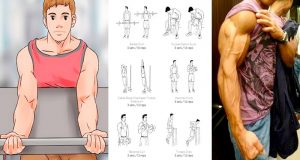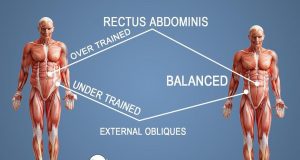There is very little in this world which can escape the push and pull of changing trends – and muscle building workouts are no exception. For the last decade, gyms up and down the country have been filled with pumped up guys, worshiping at the altar of the bench press and the dumbbell rack.
Yet, what happens if you turn up for your session and there is a queue of hulking gents hogging the rack? What if you cannot make it to the gym at all? You might have to work away from home. You might have a hard month and have to cancel your membership outright. Are you supposed to just let all of those hard won gains go to waste?
Of course not – men built mass before the invention of sophisticated gym machines and they can still do it now. In fact, this more organic way of building muscle (commonly referred to as bodyweight training or calisthenics) has slowly grown in popularity over the last five years. There are now more guys choosing to trust their bodies and acquire mass the natural way.
Whilst weight training with apparatus is certainly not a bad way to sculpt and tone the chest, arms, and back, a narrow emphasis on assisted training often leads to a physicality which is overly reliant on a limited range of forms. Alternatively, calisthenics (or bodyweight training), which tones and shapes, via strength training without weights, encourages the body to become flexible, supple, incredibly strong under pressure.
Balanced Calisthenics for Sustainable Mass
The real power in calisthenics training lies with the fact that it focuses on movements which involve multiple muscles. It does not try to pick out and strengthen separate muscle groups. This is something which can feel rather alien to anybody who is unfamiliar with bodyweight exercises, but its value quickly becomes clear when trying to learn how to master tricky moves like the one arm pull up.
Clearly, a one arm pull up is going to require super strong arms and laterals, but it needs more than this. In fact, it cannot be done without the ability to regulate strength and tension across the whole of the body. This is what calisthenics does; it involves the whole body as a cohesive unit, order to create balanced and even centers of mass.
The core tenets of calisthenics strength training exhibit a direct physical expression, as the strength to weight balance needed to carry out high level exercises makes precise demands on the body. For this reason, calisthenics experts work towards finding the perfect balance between muscle mass and body fat, so that no cycle, movement, or exercise is beyond them.
Calisthenics for the Abs
The best calisthenics ‘projects’ begin right at the center. This is important because, in order to use your own weight as a tool, you first need to train your abs to withstand the pressure – calisthenics routines always rely on the abs. It will start to show after a couple of months too, so keep that end goal in mind if the work feels intimidating.
The windshield wiper and the hanging leg raise are both great moves for working the abs. In fact, any kind of bar work is bound to be valuable. The classic bar move puts pressure on the serratus anterior, so it produces visible changes within the torso very quickly. If you want that killer serratus edge and a six pack to die for, this is the way to go.
Calisthenics for the Arms
To start making gains in this area, you do not even have to switch up your moves all that much – bar work happens to be great for arms too, especially biceps. The truth is that your arms are going to get a more solid workout from chin up reps than they are curls, so keep using your own weight as tool and start worshiping the natural way.
There is a wide range of different moves that you could try here; everything from overhand pull ups to underhand chins, the thick bar, the switch grip, and pulling up from anything which is strong enough to take your weight. After a few months, you will start to notice an incredible increase in tensile capacity. You might start to look a bit like Popeye too, what with those arms.
Calisthenics for the Chest and Back
It should come as no surprise to find that extremely broad laterals are a real sign of an accomplished calisthenics built physique. As there is no narrow focus on picking out and separately working the arms, it becomes easier to realise the true potential of the laterals with the use of muscle ups, pull ups, bar levels, and moves like the human flag.
And now to the big boss of calisthenics; the classic push up. It remains one of the finest and most efficient unassisted bodyweight movements. However, too many guys are tempted to just get to grips with the boring old signature push up – take things further and make it exciting. You should always remember that if it is easy, your body is not working as hard as it should.
Putting Together the Right Calisthenics Routine
The following three day split calisthenics routine is a fairly basic one, but it will encourage the growth of new muscle. It can be performed with the use of exterior weights, or you can go solo and pump it out unassisted – the choice is yours.
Also, you can make the routine harder, if you need to, by altering the incline of push ups, restricting points of contact, and expanding the range of motion, in order to definitively answer the question ‘Can calisthenics build mass?’
Workout One: Pushing Movements + Core
Exercise – Sets – Reps – Rest
Weighted Push-up – 3 – 8-12 – 90 sec.
Weighted Push-up, feet elevated – 3 – 8-12 – 90 sec.
Handstand Push-up – 3 – 8-12 – 90 sec.
Hanging Leg Raise – 3 – 12-15 – 90 sec.
Windshield Wipers – 3 – 12-15 – 90 sec.
Workout Two: Pulling Movements + Core
Exercise Sets Reps Rest
Pull-up – 3 – 8-12 – 90 sec
Neutral grip pull-up – 3 – 8-12 – 90 sec
Chin-up – 3 – 8-12 – 90 sec
Dragonflags – 3 – Failure – 180 sec
Workout Three: Legs and Conditioning:
Exercise – Sets – Reps – Rest
100-meter Sprint – 3 – 150 sec
50 meter run, than 50 meter walk – 2 – 5 – 240 sec
Pistol Squats – 3 – Pre-Fail – 150 sec.
7 Jump Squats
7 Jump Lunges (left)
7 Jump Lunges (right) – 3 – 90 sec.
 Crossfit Blogger News, Information and Bestselling Products
Crossfit Blogger News, Information and Bestselling Products




